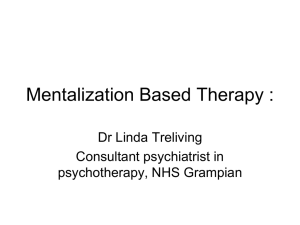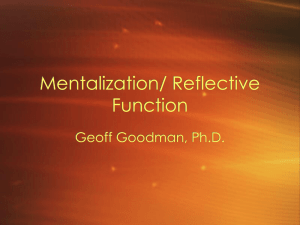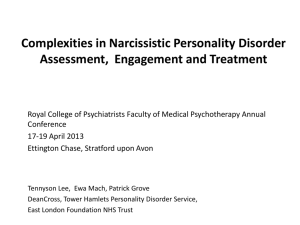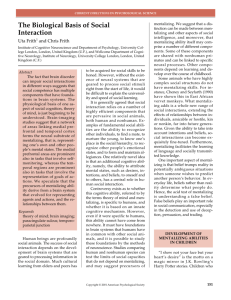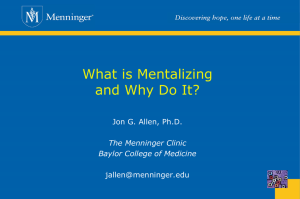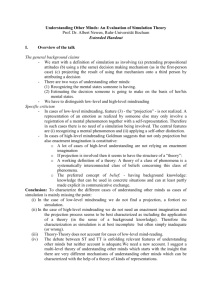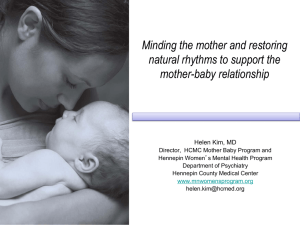Mentalizing
advertisement
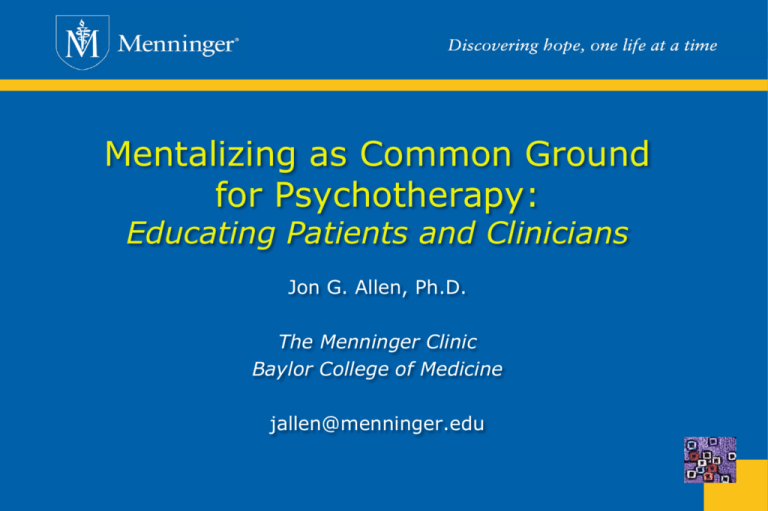
Mentalizing as Common Ground for Psychotherapy: Educating Patients and Clinicians Jon G. Allen, Ph.D. The Menninger Clinic Baylor College of Medicine jallen@menninger.edu Collaboration Colleagues Peter Fonagy, Mary Target & Anthony Bateman; Efrain Bleiberg, Pasco Fearon, Toby HaslamHopwood, Elliot Jurist, George Gergely, Jeremy Holmes, Linda Mayes, Richard Munich, Lois Sadler, John Sargent, Carla Sharp, Arietta Slade, Helen Stein, Stuart Twemlow, Laurel Williams Consortium University College London, Anna Freud Centre, Yale Child Study Center, The Menninger Clinic, Human Neuroimaging Laboratory at Baylor College of Medicine Books Fonagy, Gergely, Jurist & Target (2002). Affect regulation, mentalizing, and the development of the self. New York: Other Press. Bateman & Fonagy (2004). Psychotherapy for borderline personality disorder: Mentalization-Based Treatment. New York: Oxford University Press. Bateman & Fonagy (2006). Mentalization-Based Treatment for borderline personality disorder: A practical guide. New York: Oxford University Press. Allen & Fonagy, Eds. (2006). Handbook of Mentalization-Based Treatment. Chichester, UK: John Wiley & Sons. Allen, Fonagy, & Bateman (2008). Mentalizing in clinical practice. Washington, DC: American Psychiatric Publishing. Definitions of “mentalizing” mentalizing is a form of imaginative mental activity, namely, perceiving and interpreting human behavior as conjoined with intentional mental states (e.g., needs, desires, feelings, beliefs, goals, purposes, and reasons) Shorthand • attending to mental states in self and others • holding mind in mind • • • holding heart and mind in heart and mind mindfulness of mind understanding misunderstandings Part I Mentalizing as a common factor in psychotherapeutic treatment A capsule history of “mentalizing” First recorded use of the word, 1807 First appeared in Oxford English Dictionary, 1906 give a mental quality to; picture in the mind; cultivate mentally Used in French psychoanalytic literature in late 1960s Employed in understanding autism in 1989 (Morton) Employed in understanding developmental psychopathology in 1989 (Fonagy) and extended to treatment of BPD (Bateman & Fonagy) Advocated as a common factor in psychotherapeutic treatment (Allen, Fonagy & Bateman) Much, if not all, of the effectiveness of different forms of psychotherapy may be due to those features that all have in common rather than those that distinguish them from each other. —Jerome Frank (1961): Persuasion and healing What is the therapeutic alliance if not an attachment bond? —Jeremy Holmes (2001): The search for the secure base Mentalizing is the most fundamental common factor among psychotherapeutic treatments…perforce, clinicians mentalize in conducting psychotherapies and also engage their patients in doing so. —Allen, Fonagy, & Bateman, Mentalizing in Clinical Practice In advocating mentalization-based treatment we claim no innovation. On the contrary, mentalization-based treatment is the least novel therapeutic approach imaginable. —Allen & Fonagy, Handbook of Mentalization-Based Treatment mentalizing, even if not always explicit in our language, is implicit in many forms of psychotherapy…Allen and colleagues, of course, have already said this, when they suggest: “You’re already doing it.” And indeed we are, if we’re doing our job. —Oldham (2008), Epilogue to Mentalizing in Clinical Practice Two broad questions What is distinctive about mentalizing? as a treatment approach? as a concept? What’s all the fuss about? Plakun’s Y model: Generic and specific facets cognitive-behavioral psychodynamic formulation boundaries alliance empathic listening common factors Plakun’s Y model: Generic and specific facets cognitive-behavioral psychodynamic mentalizing Treatments for BPD Dialectical Behavior Therapy Transference-Focused Psychotherapy Mentalization-Based Therapy relatively single-minded focus on mentalizing process: consistency; a style of psychotherapy Implication: extensive overlap between MBT and other treatment approaches to BPD mentalizing Mentalizing: Generic and specific facets Third-Generation CognitiveBehavioral Therapies Mentalizing Focus in Psychotherapy metacognitive approaches Acceptance and Commitment Therapy (ACT) mindfulness practice mentalizing The Menninger Clinic: Historical Context Long-term psychoanalytically oriented hospital treatment throughout most of its history in Topeka, Kansas Gradual reductions in hospital stays coupled with increasing array of partial-hospital and outpatient services Increasing theoretical eclecticism (e.g., CBT, DBT, psychoeducational approaches) Downsizing to specialty inpatient treatment programs with 4-8 week lengths of stay Relocation to Houston, Texas to partner with Baylor College of Medicine Jump-starting treatment for treatment-resistant patients Developing the “common factor” approach to mentalizing at The Menninger Clinic Wide range of disorders beyond BPD: depression, anxiety, trauma, substance abuse, other PDs Professionals in Crisis program emphasizes mentalizing; initiated psychoeducational intervention Clinicians’ resistance to “mentalizing” sounds foreign already know it all Increasing desire for conceptual coherence in a psychotherapeutic culture (integrative function) Belatedly educating clinicians after educating patients Mentalization-Based Adolescent Treatment Program developed in consultation with Peter Fonagy, Mary Target, & Anthony Bateman Complaints “Mentalization” has an intellectualizing and potentially dehumanizing ring to it and must be humanized: We must keep in mind that the mental states perceived and the process of perception are suffused with emotion; mentalizing is a form of emotional knowing A grammatical preference for the verb (or gerund) emphasizes agency, activity, and process; mentalizing is mental action; something we do Aspiring to render “mentalizing” an everyday word rather than a technical concept New words The word in language is half someone else’s. It becomes ‘one’s own’ only when the speaker populates it with his own intention….many words stubbornly resist, others remain alien, sound foreign in the mouth of the one who appropriated them and who now speaks them…Language is populated—overpopulated—with the intentions of others. Expropriating it, forcing it to submit to one’s own intentions and accents, is a difficult and complicated process. —Wertsch: Mind as action Mentalizing emotion (“mentalized affectivity”) Mentalizing • transforming non-mental into mental • mentally elaborating primitively mental experience Emotion includes much that is potentially non-mentalized • • • • non-conscious cognitive appraisals physiological arousal action tendencies and motoric activation expressive motor behavior Emotion (affect) is mentalized when felt Mental elaboration includes understanding and attributing meaning to feelings, which includes continuous conscious cognitive appraisals and reappraisals Mentalizing in the midst of emotion Mentalizing while remaining in the emotional state 1. identifying feelings • • labeling basic emotions awareness of conflicting emotions • attributing meaning to emotions (narrative) 2. modulating emotion • downward and upward 3. expressing emotion • outwardly and inwardly Two impairments of mentalizing (besides misuse): too little or too much imaginativeness nonmentalizing mentalizing distorted mentalizing concreteness, indifference, aversion grounded imagination imagination gone wild (paranoia) mindblindness excrementalizing Overlapping concepts (hairsplitting) mindblindness: antithesis of mentalizing; employed originally to characterize autism mindreading: applies to others and focuses on cognition theory of mind: conceptual framework for mentalizing, focuses on cognitive development metacognition: focuses primarily on cognition in the self decentering: observe one’s thoughts/feelings as events in mind reflective functioning: measurement of mentalizing in attachment context mindfulness: focuses on present and not limited to mental states empathy: focuses on others and emphasizes emotional states emotional intelligence: pertains to mentalizing emotion in self and others psychological mindedness: broadly defined, the disposition to mentalize insight: mental content that is the product of the mentalizing process Mentalizing as an umbrella term Full range of mental states Self and others Implicit (intuitive) and explicit (deliberate) processes Varying time frame present past future Varying scope narrow (e.g., feeling at the moment) broad (e.g., autobiographical narrative) Criticisms of “mentalizing” Choi-Kain & Gunderson (Am J Psychiatry, in press) • • • The concept is broad and multidimensional The core measure, the Reflective Functioning Scale, yields only a single score, is time-consuming and costly, and has limited research Research should focus on more limited-domain concepts for which (primarily self-report) measures have been developed (e.g., theory of mind, mindfulness, psychological mindedness, empathy, affect consciousness) Semerari, Dimaggio et al., Metacognitive Assessment Scale • • Separates self and others Differentiates four facets Identifying mental states Differentiating subjective from objective (mental states as representational) Relating mental states to each other and behavior Integrating metacognitive knowledge into abstract narratives Limitations of emphasizing process over content Mentalizing: links to other domains of knowledge THEORY OF MIND EVOLUTIONARY BIOLOGY NEUROBIOLOGY MENTALIZING PSYCHOANALYSIS ATTACHMENT ethics PHILOSOPHY philosophy of mind Mentalizing: links to other domains of knowledge THEORY OF MIND EVOLUTIONARY BIOLOGY NEUROBIOLOGY MENTALIZING PSYCHOANALYSIS ATTACHMENT ethics PHILOSOPHY philosophy of mind Part II Attachment trauma and impaired mentalizing: A focus for psychotherapy Trauma spectrum impersonal trauma interpersonal trauma attachment trauma nonhuman agent human agent attachment figure Attachment trauma: Two senses Trauma that occurs in an attachment relationship, in childhood or adulthood Trauma that adversely affects the capacity for secure attachment—the bane of the therapeutic relationship Dual liability associated with attachment trauma in childhood (Fonagy & Target) provokes extreme, repeated stress undermines the development of the capacity to regulate distress § insecure (disorganized) attachment § impaired mentalizing capacity § impaired self-regulation Intergenerational transmission of mentalizing A mother’s capacity to hold in her own mind a representation of her child as having feelings, desires, and intentions allows the child to discover his own internal experience via his mother’s representation of it; this representation takes place in different ways at different stages of the child’s development and of the mother-child interaction. It is the mother’s observations of the moment to moment changes in the child’s mental state, and her representation of these first in gesture and action, and later in words and play, that is at the heart of sensitive caregiving, and is crucial to the child’s ultimately developing mentalizing capacities of his own [Slade, 2005] Intergenerational transmission of mentalizing mentalizing [is] the mechanism by which (1) the mother-child relationship exerts its influence on the attachment security of the child and (2) the mother-child relationship influences the child’s socio-cognitive development…secure attachment is fostered through accurate and appropriate parental mentalizing of the child, which in turn positively stimulates the development of the mentalizing capacity of the child. As a result, the mentalizing child is able to form a secure attachment to the parent…The parent’s capacity to engage in accurate and appropriate mentalizing may be disrupted by a variety of child characteristics, most notably temperament. The process by which secure attachment is fostered via accurate and appropriate parental mentalizing is therefore likely to be bidirectional. (Sharp & Fonagy, 2008, Social Development) High parental reflective functioning (mentalizing) Sometimes she gets frustrated and angry (child mental state) in ways I’m not sure I understand (opacity of child’s mental state). She points to one thing and I hand it to her but it turns out that's not really what she wanted (opacity). It feels very confusing to me (mother's mental state) when I’m not sure how she’s feeing (opacity of child's mental state) especially when she’s upset. Sometimes she’ll want to do something and I won’t let her because it’s dangerous and so she'll get angry (mother recognizes diversity of mother and child mental states). (Slade, 2005) Model of intergenerational transmission and developmental psychopathology child attachment security parental attachment security child mentalizing parental mentalizing in relation to childhood attachment parental mentalizing of child emotion regulation psychosocial functioning adapted from Sharp & Fonagy (2008) Social Development Intergenerational transmission of trauma Disturbed and abusive parents obliterate their children’s experience with their own rage, hatred, fear, and malevolence. The child (and his mental states) is not seen for who he is, but in light of the parents’ projections and distortions. The infant then takes on the parent’s hatred and aggression, a primitive form of identification with the aggressor [Slade 2005] “Trauma” broadly construed ALONE AFRAID unbearable emotional states DBT: affective dysregulation + absence of experience of being mentalized feeling abandoned neglected, unloved, invisible invalidating environment IMPAIRED MENTALIZING CAPACITY BPD Mentalizing failure in traumatizing behavior traumatizer terrorizing mindblind ALONE AFRAID unbearable emotional states + absence of experience of being mentalized feeling abandoned neglected, unloved, invisible IMPAIRED MENTALIZING CAPACITY Non-mentalizing modes of experience psychic equivalence: world=mind; mental representations are not distinguished from the external reality that they represent, such that mental states are experienced as real, as in dreams, flashbacks, and paranoid delusions. [clinical example: “dead”] pretend: mental states are separated from reality but maintain a sense of unreality inasmuch as they are not linked to or anchored in reality teleological: an action-oriented mode in which mental states such as needs and emotions are expressed in action; only actions and their tangible effects—not words—count. mentalized: actions are understood in conjunction with mental states (as contrasted to the teleological mode), and mental states have neither an exaggerated sense of reality nor unreality but rather are appreciated as representing multiple perspectives on reality (as contrasted with the psychic equivalence and pretend modes). PTSD and psychic equivalence psychic equivalence mentalizing mind=world mind represents world REEXPERIENCING flashbacks & nightmares REMEMBERING as painful experience The pretend mode: bullshitting This is the crux of the distinction between [the bullshitter] and the liar. Both he and the liar represent themselves falsely as endeavouring to communicate the truth. The success of each depends upon deceiving us about that. But the fact about himself that the liar hides is that he is attempting to lead us away from a correct apprehension of reality; we are not to know that he wants us to believe something he supposes to be false. The fact about himself that the bullshitter hides, on the other hand, is that the truth-values of his statements are of no central interest to him; what we are not to understand is that his intention is neither to report the truth nor to conceal it. This does not mean that his speech is anarchically impulsive, but that the motive guiding and controlling it is unconcerned with how the things about which he speaks truly are. Frankfurt: On Bullshit An ironic mentalizing perspective on self-knowledge There is nothing in theory, and certainly nothing in experience, to support the extraordinary judgment that it is the truth about himself that is easiest for a person to know. Facts about ourselves are not peculiarly solid and resistant to skeptical dissolution. Our natures are, indeed, elusively insubstantial--notoriously less stable and less inherent than the natures of other things. And insofar as this is the case, sincerity itself is bullshit. Frankfurt: On Bullshit Applications to BPD Persons with BPD often mentalize adequately but are highly vulnerable to losing mentalizing, especially when attachment needs are activated in the context of insecure attachments (e.g., distrust; threat of loss or betrayal) frantic responses to perceived abandonment can be construed as posttraumatic reexperiencing of painful emotional states in the context of non-mentalizing attachment relationships the core “trauma” in BPD might be the failure to develop robust mentalizing capacities stemming from relative deficiency of mentalizing in early attachment relationships (with or without abuse) this trauma is associated with impaired affect regulation and impaired social cognition, especially in attachment contexts (i.e., when attachment needs are evoked), including in psychotherapy relationships, which have the potential to undermine mentalizing if too stimulating Mentalization-Based Therapy for BPD Bateman & Fonagy, American Journal of Psychiatry, 2008 Effectiveness of MBT Day Hospital vs. Treatment as Usual • • • • • • 8-year follow-up (5 years post-termination of MBT) 23% versus 74% of patients made suicide attempts fewer ER visits and hospital days; less medication use 13% versus 87% met criteria for BPD at end of follow-up Significant differences in impulsivity and interpersonal functioning (including marked improvement in intense-unstable relationships and frantic efforts to avoid abandonment) three times longer periods of good vocational functioning Minding the Baby: Sadler, Slade, & Mayes High-risk, first-time inner city parents and infants Extends from pregnancy to child’s second birthday Nurse home visitation Infant-parent psychotherapy promote mother’s mentalizing re: the self (e.g., verbalizing feelings about pregnancy) promote mother’s mentalizing re: the infant (e.g., speaking for the infant) Mentalization-Based Adolescent Treatment Program: Efrain Bleiberg, Laurel Williams, Carla Sharp Develop assessment and treatment for emerging personality disorder Assessment • • • • • • Diagnoses Mentalizing capacity Executive and cognitive functioning Trauma history Emotion regulation and risky behaviors Family functioning (parenting style, attachment, mentalizing) Part III Promoting an alliance through psychoeducation Psychoeducational Approach Purposes • • promote a therapeutic alliance draw patients’ attention to a natural process Curriculum • • • • understanding mentalizing and its development psychiatric disorders and mentalizing impairments how treatment modalities promote mentalizing mentalizing exercises (projective, metaphors, role-playing, etc.) Incorporating “mentalizing” into other psychoeducational groups • • Coping with trauma Coping with depression Articles for patients and family members Allen, Bleiberg, & Haslam-Hopwood (2003). Mentalizing as a compass for treatment. Allen, Fonagy, Bateman (2008). What is mentalizing and why do it? (Appendix in Mentalizing in clinical practice) Broad scope of mentalizing thoughts feelings self others empathy Holding mind in mind Holding mind in mind in emotional states Part IV Cultivating mentalizing in psychotherapy: Mentalizing begets mentalizing what good therapists do with their patients is analogous to what successful parents do with their children —Jeremy Holmes (2001): The search for the secure base Mentalizing as the engine of attachment: Therapist’s contribution (in caregiving role) Fostering an attachment relationship; emotional proximity Attentiveness to distress (empathy, attunement, responsiveness) “Marked” emotional responsiveness: representing the patient’s emotion to the patient rather than becoming fully immersed in it Emotional self-awareness and self-regulation Providing support, encouragement and help while appraising and respecting the patient’s competence and autonomy Questioning and challenging the patient’s perspective while providing alternative perspectives Understanding how attachment patterns are reenacted from childhood to adulthood and in the transference with the caveat that process (mentalizing capacity) is emphasized over content (specific insights) Note parallels to a secure base in supervision Core mentalizing competencies for therapists (and patients) Affective competence (Diana Fosha) How affect is handled relationally The capacity to feel and deal while relating Neither overwhelmed nor hostile to emotion in patient or self Requires affect tolerance and affect regulation Allows therapist to provide an affect-facilitating environment Note: entails “mentalized affectivity” or mentalizing emotion Narrative competence (Jeremy Holmes) Psychological equivalent of immunological competence Collaborative and coherent discourse (e.g., as in secure/autonomous AAI narratives) Balancing prose and poetry, stories and images Evident in story telling, story listening, story-understanding; story making and story breaking Narrative competence Secure attachment is marked by coherent stories that convince and hang together, where detail and overall plot are congruent, and where the teller is not so detached that affect is absent, is not dissociated from the content of her story, nor is so overwhelmed that her feelings flow formlessly into every crevice of the dialogue. Insecure attachment, by contrast, is characterized either by stories that are over-elaborated and enmeshed, or by dismissive, poorly fleshed-out accounts…[there are] three prototypical pathologies of narrative capacity: clinging to rigid stories, being overwhelmed by unstoried experience, or being unable to find a narrative strong enough to contain traumatic pain. —Jeremy Holmes (2001): The search for the secure base Our Humanity: The art of mentalizing Appeal to special abilities of analysts must not violate the following principle: It must be possible to show that the claimed capacities are refinements of ordinary human capacities, and it must be made plausible why under specified circumstances such refinement can actually occur. This can be called the continuum principle, because it postulates that the abilities claimed for analysts must be on a continuum with ordinary human abilities. —Carlo Strenger Between hermeneutics and science: An essay on the epistemology of psychoanalysis Mentalizing as the engine of attachment: patient contribution to attachment relationships Selection of attachment figures and appraisal of trustworthiness Self-awareness regarding needs and feelings Expression of emotional distress (affective competence) and context (narrative competence); associated emotion-regulation skills Appraisal of the attachment figure’s receptiveness, attunement, responsiveness (i.e., the caregiver’s mentalizing) Appraisal of the effectiveness of strategies to influence the caregiver’s responsiveness Ability to manage conflicts, understand misunderstandings, and repair ruptures Correcting and updating mental representations of self and others (internal working models) Reciprocating caregiving Mentalizing in maintaining an internalized secure base Jeremy Holmes: “the secure base can be seen not just as an eternal figure, but also as a representation of security within the individual psyche” Activating mental representations and memories of secure attachment experiences Relating to oneself in an empathic manner, for example, protective, encouraging, reassuring, accepting, compassionate, approving (mentalizing stance) Engaging in comforting and self-soothing activities Parallel contributions to mentalizing: Meeting of minds in therapy attachment & arousal mentalizing Patient attachment & arousal mentalizing current functioning attachment & arousal current functioning mentalizing attachment & arousal developmental history mentalizing Therapist developmental history A patient’s perspective on Bowlby John Bowlby: the role of the psychotherapist is “to provide the patient with a secure base from which he can explore the various unhappy and painful aspects of his life, past and present, many of which he finds it difficult or perhaps impossible to think about and reconsider without a trusted companion to provide support, encouragement, sympathy, and, on occasion, guidance.” [A Secure Base] Jon Allen: “The mind can be a scary place.” Patient: “Yes, and you wouldn’t want to go in there alone!” The ability to think and talk about past pain is a protective factor leading to secure attachment, no matter how traumatic a childhood may have been. This inspiring finding is in itself an endorsement of psychotherapy, on of whose main functions, it can be argued, is to enhance reflective function [mentalizing]. —Jeremy Holmes (2001): The search for the secure base Challenges: Simone Weil At the bottom of the heart of every human being, from earliest infancy until the tomb, there is something that goes on indomitably expecting, in the teeth of all experience of crimes committed, suffered, and witnessed, that good and not evil will be done to him. It is this above all that is sacred in every human being. Affliction is by nature inarticulate. The afflicted silently beseech to be given the words to express themselves. There are times when they are given none; but there are also times when they are given words, but illchosen ones, because those who choose them know nothing of the affliction they would interpret. Thought revolts from contemplating affliction, to the same degree that living flesh recoils from death. A stag advancing voluntarily step by step to offer itself to the teeth of a pack of hounds is about as probable as an act of attention directed towards a real affliction, which is close at hand, on the part of a mind which is free to avoid it. The Mentalizing Stance (mentalizing mindfully) Psychological aspects inquisitive, curious, playful, open-minded “not knowing” (cleverness as cardinal sin) not creating the capacity but rather promoting attentiveness to the activity of mentalizing Ethical aspects (as in parenting, for example) good will and compassion acceptance and forgiveness respect for autonomy love Therapeutic paradox activating attachment needs undermines mentalizing for patients with insecure attachment psychotherapy activates attachment needs patient must learn to mentalize in the context of intense emotional states in attachment relationships note contrast with mindfulness practice General tips on mentalizing in psychotherapy You are doing it already Cultivate alternative perspectives Balance focus on self and others Maintain an optimal level of emotional arousal Challenge patient’s assumptions about your mental states Focus on mental states in the here-and-now, in current relationships and in the transference Avoid attributing mental states to patients of which they are unaware; liable to be taken in as alien or rejected outright [extremely common in our setting with “anger”] Use “I” statements Example of “I” Statements (Bateman & Fonagy) “You are angry with me” versus “The way you are frowning makes me think that you may be feeling angry about something and I am wondering what that may be about” Mentalizing the transference validating the patient’s experience of the patienttherapist interaction exploring the current patient-therapist relationship accepting and exploring enactments, including the therapist’s own contribution and the therapist’s distortions collaborating in arriving at an understanding presenting an alternative perspective monitoring and exploring the patient’s reaction Transference work: transparency The patient has to find himself in the mind of the therapist and, equally, the therapist has to understand himself in the mind of the patient if the two together are to develop a mentalizing process. Both have to experience a mind being changed by a mind (Bateman & Fonagy)
